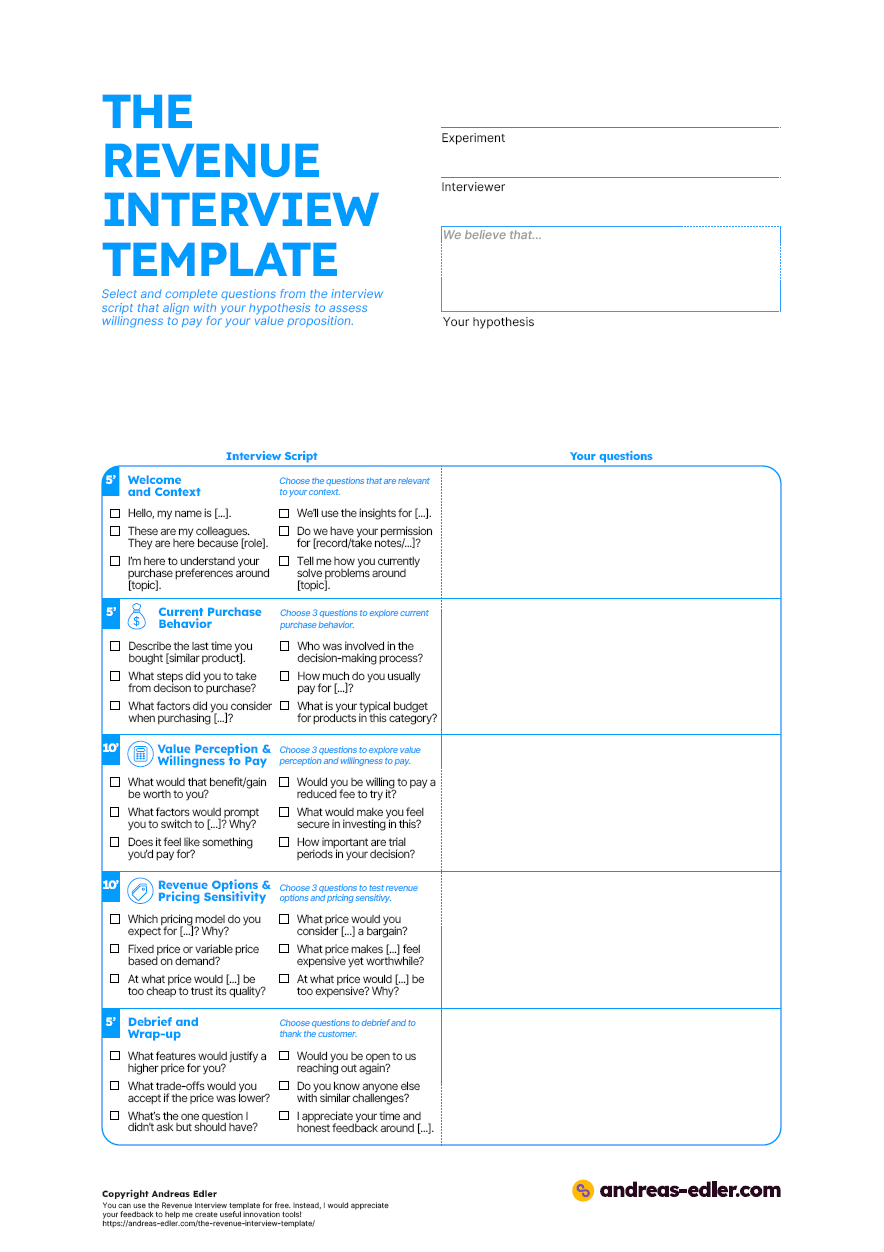The Revenue Interview Template
Uncover what customers are truly willing to pay for.
Value Perception and Willingness to Pay Questions
Select additional questions to complete the Revenue Interview Template. The value perception and willingness to pay questions explore the perceived value and uncover what customers prioritize and are willing to pay for, helping to align your solution’s pricing with its benefits.
1. Perceived Value & Benefits
Uncover if your value proposition or prototype meets the outcomes, benefits, or improvements customers value most and are willing to pay for.
- Essential Missing Elements:
“What’s missing from this idea that would make it indispensable for you?“
Identifies essential elements you need to include to drive customers to justify switching to this solution. - Defining Success:
“How would you describe success if this tool successfully solved your #1 problem?”
Test if solution outcomes are aligned with customer expectations. - Standout Features:
“Which aspects of this prototype catch your attention the most, and why?”
Uncovers potential standout features of your concept. - Quantifying Value:
“If this solution saved you significant time, effort, or money, what would that improvement be worth to you?”
Directly links benefits to monetary value, guiding your pricing strategy. - Perceived Value:
“What’s your immediate reaction to this concept? Does it feel like something you’d pay for? Why or why not?“
Provides an early signal of whether the idea resonates on a value level for willingness to pay. - Switching Triggers:
“What conditions or triggers would lead you to switch from your current solution to this new concept?”
Identifies meaningful triggers for customer action. - Addressing Major Pain Points:
“If this solution could eliminate your most frustrating pain point, what would that be worth to you?”
Links high-priority problems to revenue potential. - Comparing Alternatives:
“How does this prototype compare to the alternatives you’re currently paying for? What do you like or dislike about each?”
Helps to understand your competitive landscape and differentiators. - Daily Use & Integration:
“Can you walk me through how you’d envision using this solution in your daily routine?”
This sheds light on usability, integration, and real-life impact.
2. Willingness to Invest & Purchase Drivers
Reveals whether your potential customers are willing to pay for the perceived value and what drives them to consider a purchase based on your prototype.
- Interest & Immediate Appeal:
“If this concept were available today, would you be interested in trying it? What specifically drives that interest?”
Measures immediate interest without requiring a working product. - Willingness to Pay:
If this solution existed today, what would make you feel confident enough to pay for it?”
Reveals key proof points for your prototype’s perceived value. - Pilot/Beta Investment:
“If we launched this as a pilot or beta, would you be willing to pay a reduced fee to try it? What factors would influence your decision?“
Tests your ability to generate revenue even before a full product is available. - Internal Justification:
“How would you justify investing in this idea to your team or manager? Which outcomes or benefits would you highlight?“
Identifies the perceived value and whether it’s compelling enough to influence purchasing decisions and uncovers the metrics they’d use to advocate for adoption.
3. Evaluating MVP Risk & Purchase Decision Factors
Identifies risk concerns and effective trust-building strategies to reduce hesitation and increase purchase commitment for the value proposition.
- Risk Perception:
“What concerns or risks do you see in investing in a concept that’s still in development?”
Reveals specific aspects of the MVP that make them hesitant. - Trust & Support Options:
“What types of guarantees, trial periods, or ongoing support would help you feel secure in investing in this concept?”
Highlights methods for building trust. - Early Evidence & Validation:
“How critical is it for you to see early evidence—such as case studies, live demos, or pilot results—before committing to this solution?”
Identifies key confidence triggers that reassure customers that the concept can deliver. - Adoption Incentives:
“Would you consider testing this concept at a reduced price if it came with additional support during the trial phase?”
Explores discounted trials as an adoption tactic. - Outcome Reassurance:
“What evidence or results would make you confident that this idea could significantly improve your current process or address your key challenges?”
Clarifies key performance indicators or outcomes customers are looking for. - Investment Decision Criteria:
“When evaluating this solution, what specific criteria or proof of ROI would justify your investment?”
Identifies the most critical elements of our value proposition for your decision-making. - Future Roadmap & Development:
“How important is the development roadmap or future updates in your decision to invest, and what details would you need to see?”
Reveals if plans for future improvements can mitigate concerns. - Comparative Perspective:
“How does the risk associated with this developing solution compare to other alternatives you’re considering?”
Reveals factors that would tip the scales to switch from their current solution.

You can use The Revenue Interview Template for free. Instead, I would appreciate your feedback after at least 15 interviews to help me create useful innovation tools!